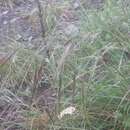Brief Summary
(
Inglês
)
fornecido por EOL authors
Nassella lepida is distributed in a portion of southwest North America with populations in California and Baja California, Mexico. It occurs on dry slopes, chaparral and oak woodland savannas at elevations below 550 meters.
Also known by the common name Foothill needlegrass, this perennial typically occurs as a tufted terrestrial plant, whose terete form stems rarely exceed one meter in height.
Comprehensive Description
(
Inglês
)
fornecido por North American Flora
Stipa lepida Hitchc. Am. Jour. Bot. 2: 302. 1915
Culms cespitose, often in large bunches, erect or spreading at base, glabrous or scaberulous, or the lower internodes pubescent, the upper ones sometimes puberulent below the nodes; sheaths glabrous, sometimes a little roughened, slightly villous at the throat; ligule very short, less than 1 mm. long; blades flat or soon involute, rather lax, glabrous or scaberulous beneath, pubescent on upper surface, 10-30 cm. long, 1-2 or even as much as 4 mm. wide; panicle open, nodding, 10-20 cm. long, the branches single, in pairs, or in clusters, ascending or more or less spreading, slender, scabrous, naked below (or with some short branches in the cluster), 5-8 cm. long, or sometimes longer, branching about the middle, bearing several or many pale or sometimes purplish spikelets, the branchlets appressed; glumes 6-8 mm. long, equal or the first a little longer, narrow, acuminate, glabrous, 3-nerved; lemma 4.5-5.5 mm. long, the callus less than 1 mm. long, barbed with white hairs, the body tapering from below the middle to the summit, brown at maturity, sparsely villous all over with white hairs or glabrate toward summit, the neck short and obscure, the summit with several short stiff appressed hairs; awn obscurely twice geniculate, scaberulous, very slender, loosely twisted to the second bend, mostly 2.5-3.5 cm. long; anthers tipped with a minute tuft of hairs.
Type locauty: Santa Barbara County. California (Chase 5611).
Distribution: Dry hills, open woods, and rocky slopes, central California to Lower California.
- citação bibliográfica
- Albert Spear Hitchcock. 1935. (POALES); POACEAE (pars). North American flora. vol 17(6). New York Botanical Garden, New York, NY
Physical Description
(
Inglês
)
fornecido por USDA PLANTS text
Perennials, Terrestrial, not aquatic, Stems nodes swollen or brittle, Stems erect or ascending, Stems geniculate, decumbent, or lax, sometimes rooting at nodes, Stems caespitose, tufted, or clustered, Stems terete, round in cross section, or polygonal, Stem internodes hollow, Stems with inflorescence less than 1 m tall, Stems, culms, or scapes exceeding basal leaves, Leaves mostly basal, below middle of stem, Leaves mostly cauline, Leaves conspicuously 2-ranked, distichous, Leaves sheathing at base, Leaf sheath mostly open, or loose, Leaf sheath smooth, glabrous, Leaf sheath hairy at summit, throat, or collar, Leaf sheath and blade differentiated, Leaf blades linear, Leaf blades very narrow or filiform, less than 2 mm wide, Leaf blades 2-10 mm wide, Leaf blades mostly flat, Leaf blade margins folded, involute, or conduplicate, Leaf blades more or less hairy, Leaf blades scabrous, roughened, or wrinkled, Ligule present, Ligule an unfringed eciliate membrane, Inflorescence terminal, Inflorescence an open panicle, openly paniculate, branches spreading, Inflorescence a contracted panicle, narrowly paniculate, branches appressed or ascending, Inflorescence solitary, with 1 spike, fascicle, glomerule, head, or cluster per stem or culm, Inflorescence branches more than 10 to numerous, Flowers bisexual, Spikelets pedicellate, Spikelets dorsally compressed or terete, Spikelet less than 3 mm wide, Spikelets with 1 fertile floret, Spikelets solitary at rachis nodes, Spikelets all alike and fertille, Spikelets bisexual, Spikelets disarticulating above the glumes, glumes persistent, Spikelets disarticulating beneath or between the florets, Rachilla or pedicel glabrous, Glumes present, empty bracts, Glumes 2 clearly present, Glumes distinctly unequal, Glumes equal to or longer than adjacent lemma, Glume equal to or longer than spikelet, Glumes 3 nerved, Lemma coriaceous, firmer or thicker in texture than the glumes, Lemma 5-7 nerved, Lemma body or surface hairy, Lemma rugose, with cross wrinkles, or roughened, Lemma distinctly awned, more than 2-3 mm, Lemma with 1 awn, Lemma awn 1-2 cm long, Lemma awn 2-4 cm long or longer, Lemma awned from tip, Lemma awn twisted, spirally coiled at base, like a corkscrew, Lemma awn twice geniculate, bent twice, Lemma apices fused distally into a crown, Lemma margins inrolled, tightly covering palea and caryopsis, Lemma straight, Callus or base of lemma evidently hairy, Callus hairs shorter than lemma, Lemma surface pilose, setose or bristly, Palea present, well developed, Palea membranous, hyaline, Palea shorter than lemma, Stamens 3, Styles 2-fid, deeply 2-branched, Stigmas 2, Fruit - caryopsis, Caryopsis ellipsoid, longitudinally grooved, hilum long-linear.
Nassella lepida: Brief Summary
(
Inglês
)
fornecido por wikipedia EN
Nassella lepida (syn. Stipa lepida) is a species of grass known by the common names foothill needlegrass, foothills nassella, foothill stipa, small-flowered stipa, small-flowered needlegrass, and smallflower tussockgrass.
- licença
- cc-by-sa-3.0
- direitos autorais
- Wikipedia authors and editors

